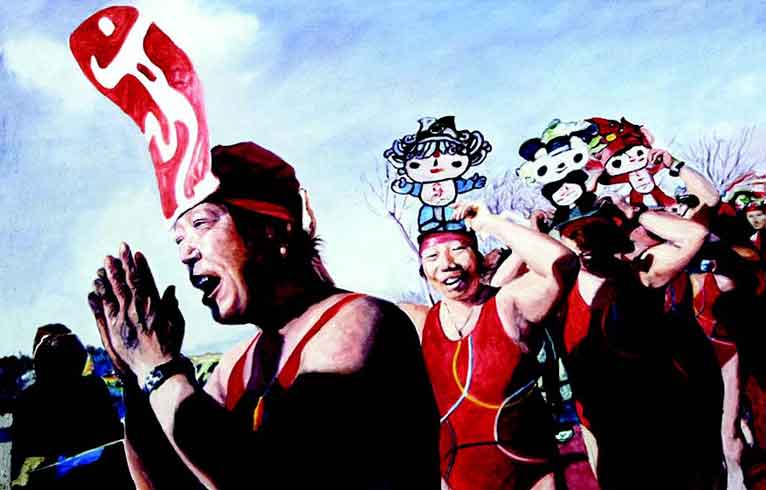XIA XING
| May 23, 2011 | Post In LEAP 8

In 2007, Xia Xing became a household name while working as a reporter for The Beijing News. At the time, perhaps he was unaware that he had already uncovered the theme that would drive his creative work over the next four years. However, he was likely appreciative of the newspaper’s broad influence—with nearly 450,000 copies in daily circulation it undoubtedly shapes public opinion in the capital. There was also a sense of distance between the high-speed economic transformations that surrounded him and the pace of everyday life; and he was probably still in many senses a stranger in a strange land—not new to the capital, but certainly not a long-time resident. He was thus in a position to view Beijing through a defamiliarized lens. In his search for subject matter, Xia started with the newspaper’s front-page headlines, and began rendering their accompanying photographs in oil paintings. He would catch the breaking news stories, and struck with horror, reproduce the images one stroke at a time. Yet the influx of shocking stories continued without any signs of abatement, and his reproductions in turn became a way to document fleeting events in a more lasting medium.
In this exhibition, the artist’s intentions and techniques at times seem overpowered by the larger thematic concept. Social reality is without a doubt just one possible source of inspiration. Xia Xing also worked in printing and photography for some time. Now with oil paint as his medium, the form has changed, but the approach has been maintained. We are reminded of a strand that runs through the body of his work: unlike others who concern themselves with people’s everyday lives, Xia focuses on “the ways in which people’s everyday lives are presented by the media.” There are two distinct dimensions here: “daily life” and “daily life as portrayed by the media.” Xia Xing positions himself in a third role: the mediator of the mediated. However, to wax philosophical about his position might actually be digressing from the substance of the exhibition itself. In fact, Xia has done something very simple. He has copied and recorded. In a series of works where theme overshadows method, Xia has first been influenced by subject matter.
Xia Xing’s choice of subject matter is born out of a devotion to representing his social reality—a devotion to putting his own identity and work as an artist in service of the evolution of society. At the most basic level, he embodies the qualities of a documentarian, imploring all of the disheartened creatures of the earth not to forget so easily “what happened here.” In the curator’s words, “Four years spent focusing a pair of ruthless eyes on the country’s future—as well as on its particularly forgetful collective memory—is a sufficient span of time.” The exhibition’s line of thought mirrors Qiu Xiaofei’s attitudes toward his past work— namely, the notion of “slowing down time.” But when Xia chose The Beijing News as his object of study, he made an unhesitating assumption about the objectivity of what is represented in the newspaper’s reports. From the perspective of intellectual circles, both East and West, this is an interesting stance to take. No matter from what point of view or school of thought, intellectuals have reached a consensus that there is a marked divergence between the institution of “public media” and the truth of “private reality.” But Xia has taken a whole-hearted confidence in The Beijing News. Perhaps this is a manifestation of his harboring hopes for what still qualifies as a young publication. His conviction is no doubt sincere, but it simultaneously lacks a sense of more rigorous contemplation. It becomes apparent, therefore, that talking about his work in terms of “reality” becomes highly problematic. Nonetheless, Xia’s four-year engagement with his own reality reflects a kind of passion worthy of abiding recognition. Liu Xi


